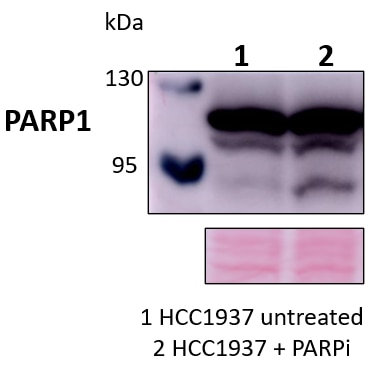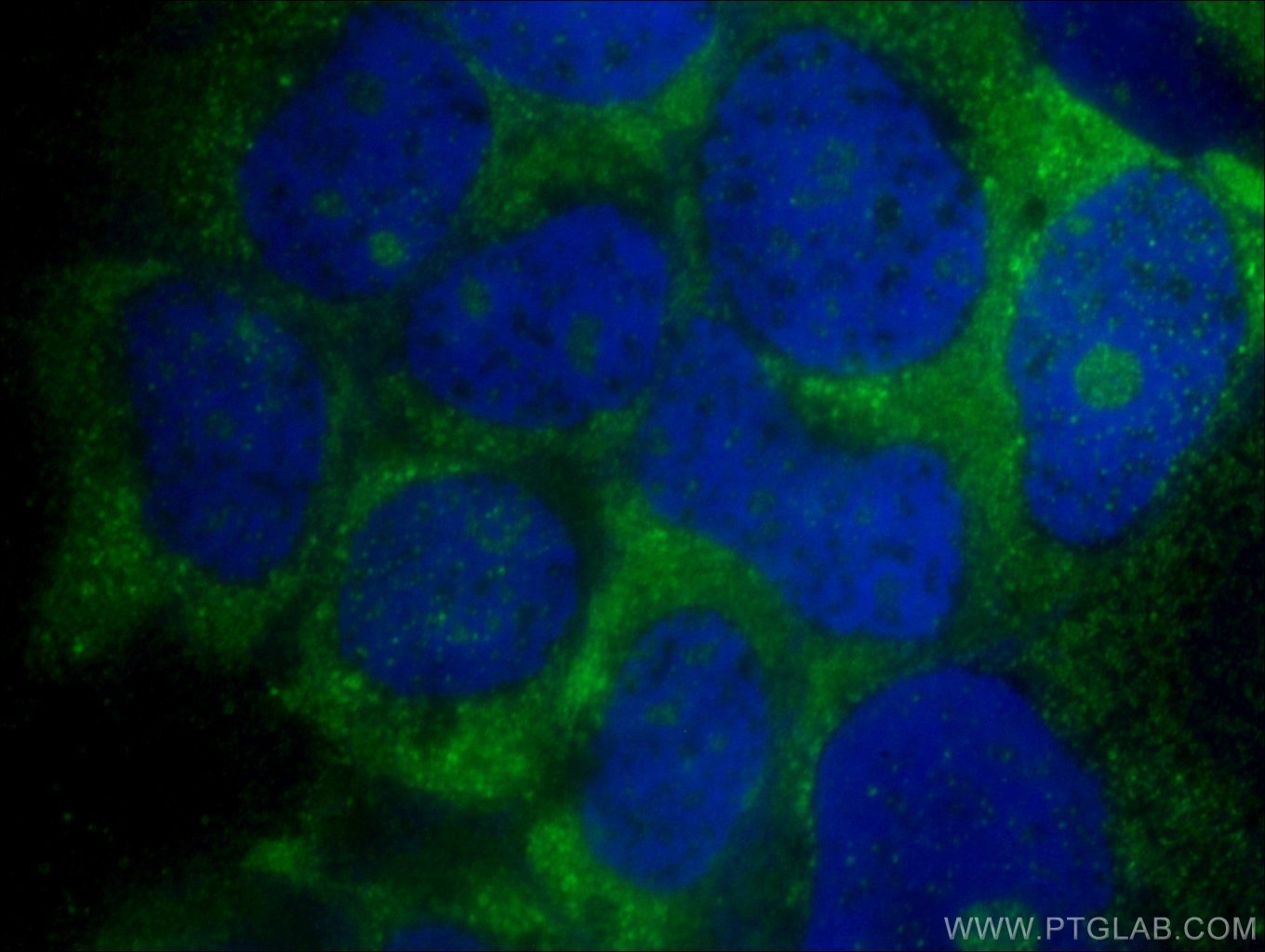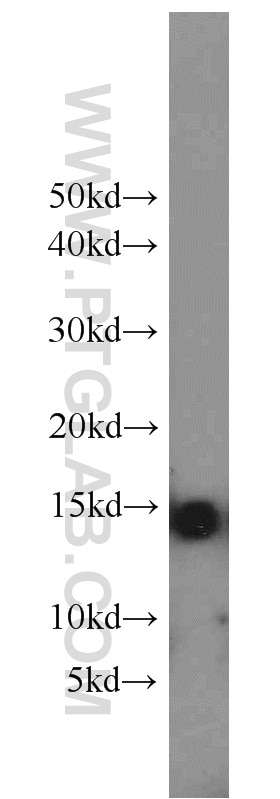- Featured Product
- KD/KO Validated
PARP1 Polyclonal antibody
PARP1 Polyclonal Antibody for WB, IHC, IF/ICC, IF-P, FC (Intra), IP, ELISA
Host / Isotype
Rabbit / IgG
Reactivity
human, mouse, rat and More (7)
Applications
WB, IHC, IF/ICC, IF-P, FC (Intra), IP, CoIP, ChIP, ELISA
Conjugate
Unconjugated
661
Cat no : 13371-1-AP
Synonyms
Validation Data Gallery
Tested Applications
| Positive WB detected in | HeLa cells, Jurkat cells, C6 cells, Fas antibody treated HeLa cells, Cobalt Chloride treated HeLa cells, THP-1 cells |
| Positive IP detected in | K-562 cells |
| Positive IHC detected in | mouse colon tissue, human breast cancer tissue, human lung cancer tissue, mouse testis tissue Note: suggested antigen retrieval with TE buffer pH 9.0; (*) Alternatively, antigen retrieval may be performed with citrate buffer pH 6.0 |
| Positive IF-P detected in | mouse testis tissue |
| Positive IF/ICC detected in | HEK-293 cells, MCF-7 cells |
| Positive FC (Intra) detected in | K-562 cells |
Recommended dilution
| Application | Dilution |
|---|---|
| Western Blot (WB) | WB : 1:1000-1:8000 |
| Immunoprecipitation (IP) | IP : 0.5-4.0 ug for 1.0-3.0 mg of total protein lysate |
| Immunohistochemistry (IHC) | IHC : 1:1000-1:4000 |
| Immunofluorescence (IF)-P | IF-P : 1:50-1:500 |
| Immunofluorescence (IF)/ICC | IF/ICC : 1:50-1:500 |
| Flow Cytometry (FC) (INTRA) | FC (INTRA) : 0.40 ug per 10^6 cells in a 100 µl suspension |
| It is recommended that this reagent should be titrated in each testing system to obtain optimal results. | |
| Sample-dependent, Check data in validation data gallery. | |
Published Applications
| KD/KO | See 5 publications below |
| WB | See 625 publications below |
| IHC | See 26 publications below |
| IF | See 18 publications below |
| IP | See 8 publications below |
| CoIP | See 3 publications below |
| ChIP | See 2 publications below |
Product Information
13371-1-AP targets PARP1 in WB, IHC, IF/ICC, IF-P, FC (Intra), IP, CoIP, ChIP, ELISA applications and shows reactivity with human, mouse, rat samples.
| Tested Reactivity | human, mouse, rat |
| Cited Reactivity | human, mouse, rat, pig, canine, monkey, chicken, bovine, sheep, fungus |
| Host / Isotype | Rabbit / IgG |
| Class | Polyclonal |
| Type | Antibody |
| Immunogen | PARP1 fusion protein Ag4193 |
| Full Name | poly (ADP-ribose) polymerase 1 |
| Calculated Molecular Weight | 1014 aa, 113 kDa |
| Observed Molecular Weight | 113-116 kDa, 89 kDa |
| GenBank Accession Number | BC037545 |
| Gene Symbol | PARP1 |
| Gene ID (NCBI) | 142 |
| RRID | AB_2160459 |
| Conjugate | Unconjugated |
| Form | Liquid |
| Purification Method | Antigen affinity purification |
| Storage Buffer | PBS with 0.02% sodium azide and 50% glycerol pH 7.3. |
| Storage Conditions | Store at -20°C. Stable for one year after shipment. Aliquoting is unnecessary for -20oC storage. 20ul sizes contain 0.1% BSA. |
Background Information
PARP1 (poly(ADP-ribose) polymerase 1) is a nuclear enzyme catalyzing the poly(ADP-ribosyl)ation of many key proteins in vivo. The normal function of PARP1 is the routine repair of DNA damage. Activated by DNA strand breaks, the PARP1 is cleaved into an 85 to 89-kDa COOH-terminal fragment and a 24-kDa NH2-terminal peptide by caspases during the apoptotic process. The appearance of PARP fragments is commonly considered as an important biomarker of apoptosis. In addition to caspases, other proteases like calpains, cathepsins, granzymes and matrix metalloproteinases (MMPs) have also been reported to cleave PARP1 and gave rise to fragments ranging from 42-89-kDa. This antibody was generated against the C-terminal region of human PARP1 and it recognizes the full-length as well as the cleavage of the PARP1.
Protocols
| Product Specific Protocols | |
|---|---|
| WB protocol for PARP1 antibody 13371-1-AP | Download protocol |
| IHC protocol for PARP1 antibody 13371-1-AP | Download protocol |
| IF protocol for PARP1 antibody 13371-1-AP | Download protocol |
| IP protocol for PARP1 antibody 13371-1-AP | Download protocol |
| Standard Protocols | |
|---|---|
| Click here to view our Standard Protocols |
Publications
| Species | Application | Title |
|---|---|---|
Cell Res Mannose antagonizes GSDME-mediated pyroptosis through AMPK activated by metabolite GlcNAc-6P | ||
Mol Cancer YTHDF2 mediates the mRNA degradation of the tumor suppressors to induce AKT phosphorylation in N6-methyladenosine-dependent way in prostate cancer. | ||
Exp Mol Med Protective effect of hepatocyte-enriched lncRNA-Mir122hg by promoting hepatocyte proliferation in acute liver injury | ||
Nat Commun The ATM and ATR kinases regulate centrosome clustering and tumor recurrence by targeting KIFC1 phosphorylation. | ||
Reviews
The reviews below have been submitted by verified Proteintech customers who received an incentive for providing their feedback.
FH K. (Verified Customer) (10-26-2023) | this antibody worked well, but some times we need to add it at high concentrations
|
FH Priscila (Verified Customer) (04-25-2023) | Very clean detection on western blotting. Sharp bands, and the p89 proteolytic fragment of PARP1 is detectable (tested conditions: 25µg of protein lysate and 1:2,500 dilution for endogenous PARP1 in HEK293T cells).
 |
FH Ruchi (Verified Customer) (12-09-2022) | The Ab was used for IF at a dilution of 1:100 for staining mice skin wounds. This is a nuclear protein and so required an additional time for fixation (30 minutes in 4% paraformaldehyde) and permeabilization by chilled methanol for 10 minutes. The blocking buffer used was 4% BSA.
|
FH Marina (Verified Customer) (05-30-2022) | In the blot we could detect native PARP1 as well as its cleaved 89 kDa form after PARP inhibitor treatment
 |
FH Huanzhou (Verified Customer) (04-08-2022) | This product works well for WB.
|
FH Azita (Verified Customer) (06-02-2021) | Western blot analysis using PARP1 polyclonal antibody in NSC34 cell line at dilution of 1:500.
|
FH Brandon (Verified Customer) (02-01-2019) | Detected Full-length and cleaved PARP-1. Also detected a smaller fragment in mouse mouse liver tissue.
|

























